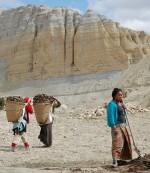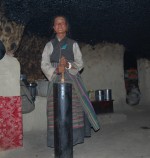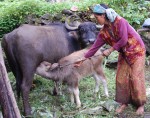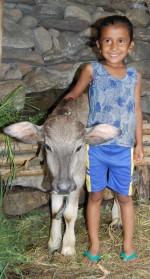








Travel report Nepal August/September 2008by Stefanie ChristmannIn August/September 2008, Stefanie Christmann, chairwoman of Self Help by Donkeys travelled in Upper and Lower Mustang (Annapurna region). Carbon emissions from her travel were offset by a donation to www.atmosfair.de. As always, her flight and all other expenses were financed privately. Shanta K. N., a 53-year old widow from a village near Lete (Lower Mustang) was one of the poorest women who received a cow in 2007. A mother of six, she was working as a washer woman and fetched wood from the forest for others (earning 0.70 to 1 Euro a day – if there was work). With her cow she now earns 2.50 to 3 Euro a day selling milk. Shanta bought three hens and five chicken. By now, she has two female calves – and plenty of dung. Thus, she cleared a stretch of bush behind her house and terraced it. She grows cabbage, radish and runner beans from seed and harvests over 100 heads of cabbage which she is selling to the guesthouses along the trekking routes. As she has so much dung she leased a field where she grows corn – for her family and as additional fodder in winter. Forty-eight year old Ottar K. from Taglung received her cow in 2007. She is looking after her grandchild. With the labour intensive production of ghee (a very long-lasting source of fat made from clarified butter) she actually earns 12 Euro per week. She lives in a small village in the forest and sells her ghee in the village and to guesthouses along the trekking route in Lower Mustang, located a couple of hours walk from her village. She has also started a vegetable garden with a field. She has a male calf and intends to keep it: for the dung and because the grown oxen will eventually earn her 2 Euro a day on hire for ploughing. In barren Upper Mustang, very much a mountain desert with villages as small oases, the single mothers use dung as fuel for cooking. Owning a cow means an end to days of searching for dung in the hills. In the regions with lush vegetation (Myagdi and parts of Lower Mustangs), almost all mothers use the dung to start their own vegetable gardens or fields. Some widows, who cultivated the fields of their deceased husbands, had to fetch about 12 kg grass for other people’s cows every day for three months to get dung for their field before they received their own cows. The widow Prossila T. from Sauru had to feed the goat herder– as well as her four children - for six weeks every year to be allowed to collect goat dung for her field. A day labourer, she is at the moment living rent free in one of her father-in-law’s houses. Whether she will be allowed to stay when he dies is not clear. Especially in northern Upper Mustang, many single mothers are entirely dependent on the goodwill of relatives – or on their own mothers well being, as polyandry is still common here (one woman often has to marry several brothers to avoid distribution of the estate). As a consequence, many other women cannot find a husband. I spent one week in Lo Mantang and together with Laxmi Gauchan (Sahayog Himalaya-Nepal) and a local guide travelled on foot and partly on horseback to very remote villages to spread the project. One pass beyond Kimling, for example, in a tiny village with 28 buildings, we chose eight (!) single mothers for our project. Or take Samsung: In this village (82 inhabitants) near the Tibetan border, which is very hard to reach even on horseback, five single mothers will now receive good cows from Lo Mantang. Thirty-six years old Nisung G., for example, used to live with her four-year old son in her father’s house. When her brother got married, she had to look for shelter elsewhere. At the moment she is living in a shed without windows. We had already met 30 year-old Tamdin D. carrying a heavy load of stones on our way to Samsung. She is presently living with a cousin and to avoid the risk of having to live in a similar rough dwelling has started to build her own house (one room, about 20 sqm – but an immense effort!). The single mothers travel as far as Choessar (fields) and Lo Mantang (building sites) to find work for several weeks. In Choessar, the cows were allocated just in time. Water had got into several of the rock caves inhabited by single mothers/grandmothers. With the income from selling butter (necessary regional staple for Tibetan tea) and “churpi” (hard cheese made from buttermilk) 39 year-old Yangdin G. is now able to afford the 3 Euro rent for the room where she is now living with her daughter. For a day labourer without a cow of her own, tenancy is a risky and heavy burden. The widow Tsering A., who has lived all her life in a rock cave, wants to move as well – but not for a few years: „When my calf is big enough to sell.“ This grandmother is looking after her three year old grandson and needs as much security as possible and will only risk tenancy once her nest egg has grown. Until recently, this 65-year old women used to do physically hard work as a day labourer, e.g. installing the water supply for the village. When she found out in 2007 that she will receive a cow, Tsering worked for two months on the fields of other families to be able to afford her own butter churn. – Most women initially borrow one in the village. While almost all single mothers are illiterate and in the north speak only Tibetan, not Nepali, they are quite shrewd: For example, when Duki G. from Lo Mantang lost a calf three months after it was born, she stuffed the calf’s skin with hay and now gives this to the cow to lick especially while milking. This way the cow continues to give milk – as if her calf was still alive. If there is not enough milk, some single mothers allow the calf to be with the cow for a short time with the result that the cows produce more milk. The women look after their animals very well: fodder, space to roam, stable – and the vet. Some single mothers who received pregnant cows visited the vet to get information on how to look after their cows to ease the birth and to ensure a healthy calf. Still, the cow of 51-year old Tolma Y. G. from Lo Mantang gave birth to a very small calf. When she milks the cow in the morning before bringing her out to pasture with the other cows of the village, she uses the milk not for butter but feeds it during the day to the calf with a spoon: „Just until it gets a bit stronger! So it won’t lack anything until the cow comes home from the pasture.“ The joy and gratitude for the animals is overwhelming. In Gelling (Upper Mustang) all seven single mothers who had received a cow visited us in our accomodation early in the morning shortly before we had to leave. Each brought a white scarf and a full 1 litre flask of butter tea for us to drink! In Myagdi and the southern part of Manaslu, where the single mothers can look after a water buffalo, most wish for a water buffalo despite the fact that feeding is a lot of extra work. The income from selling milk is similar to that from good cows. But while cows are cared for until death, water buffalo are slaughtered once they are too old to have calves. The meat can earn 160-200 Euro. In Myagdi, several very young single mothers received water buffalo. The women were deserted by their husbands after a few years of marriage. For the time being they found shelter with relatives and are making ends meet with insecure day labourer’s jobs. Twenty-one year old mother of two Pipala R. is now selling milk daily to tea houses (1.50 Euro). Twenty-six year old mother of two, Kortko D.B. used to buy grain to make wine for sale before she swapped her water buffalo milk for grain. Now she grows her own grain for wine and earns 3.50 Euro a day. Twenty-three year old Muna J. (one daughter) plans to eventually sell her (male) calf using the profits to open up her own tea house. Unfortunately, we could distribute only seven horses to midwives/female amchis to date because there are not many well-trained midwives. Many of the midwives have only had one week of training in a health centre. According to their reports, the training focussed more on baby care. Hence, their knowledge of obstetrics is limited. Together with Sahayog Himalaya-Nepal we decided to send next winter about 100 midwives from the northern Annapurna and Manaslu region to Pokhara to attend various training sessions offered by a gynecologist in the hospital. Upon completion of this training, the midwives will receive their horses. We believe it would make little sense if we distributed the horses beforehand. The women in the villages will discuss and reach a consensus on which woman is most suited for the hospital training. Important criteria are reliability, availability in the village during winter and age. I was most impressed when in Samar (Upper Mustang) 50-year old midwife Dolka. G. explained quite naturally: „Tschensom G. should go for the training and get my horse, she is the younger one.“ In the Manaslu region, the first 56 nak (female yak) were allocated in the summer. Currently, water buffalo are purchased, followed by donkeys (both for Manaslu). At the same time, more water buffalo are allocated in Myagdi and in Upper Mustang, cows. In late autumn, single mother will be selected in the Dolpa region. Only in a few areas there are weekly cattle markets in the mountains. Instead, animals are purchased directly from individual farmers. The care and attention with which Sahayog Himalaya-Nepal plans and pursues the project in these very different regions with difficult conditions (access, weather etc.) together with local staff is impressive – as is the extensive book keeping in the selection of single mothers, and the purchase and allocation of animals. In the regions where we allocate cows with Jersey cross breeding we also purchase a respective bull so that the women do not have their cows fertilised by local Lullu bulls which pass on only a 1 l milk yield. The two nak herds will also receive a yak. This year, we will transfer 500,000 Euro to Sahayog Himalaya-Nepal (for the allocation of animals and midwife training). Local cows cost on average 90 Euro, cows with Jersey cross breading 380 Euro, nak and water buffalo 340 Euro, horses for midwives cost 600 Euro each (this always includes the search for suppliers and transport). Our buyers report that donkeys cost between 100 and 130 Euro. Following detailed information and discussion, each single mother decides herself which of the possible animals she wants. Hopefully, we will be able to purchase offspring from these high-quality project animals in the coming years for further allocation. |
Other travel reports:
August 2011
September 2010
February 2009
September 2007

Shanta K.N. in her cabbage field.

Collecting dung is an unpaid women's labour, and
women working in construction are paid very little.

Laxmi Gauchan of Sahayog Himalaya-Nepal

Tamdin D. building her house.

Tsering A. making butter in her cave.

Four of the eight women who received a cow each in isolated Chungjung.

Tsering N. from Tsarang happy with her cow and her calf.

Punisara P., a widow with four children, with her water buffalo and her calf.

Muna J.'s six year old daughter shows off the water buffalo calf.

Midwife Tschensom G.
home | the project | news | on tour | on site | ideas | partners | the board | help | mail
Account No. 106 57575 - Sparkasse KölnBonn - BLZ 370 501 98
For donations from outside Germany - IBAN: DE02 3705 0198 0010 6575 75 - Swift-BIC: COLSDE33
please only bank transfers in Euro, no checks!